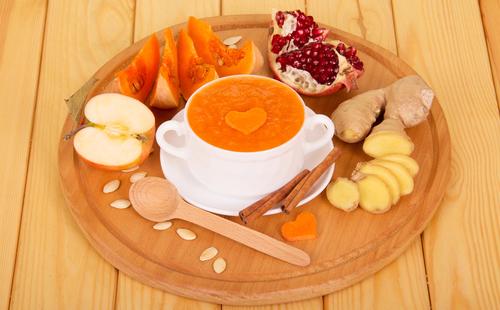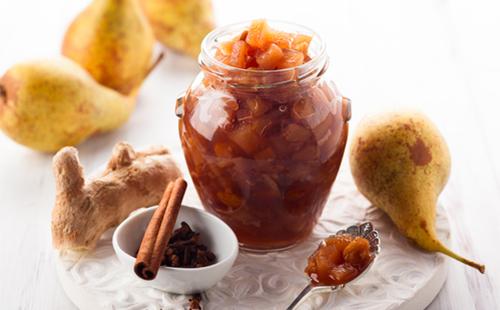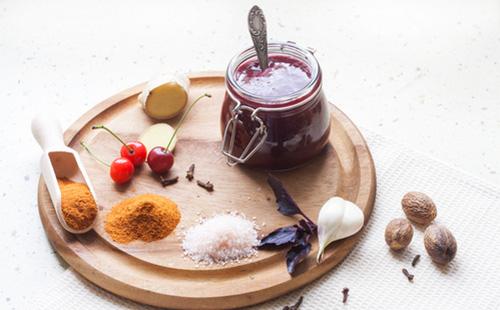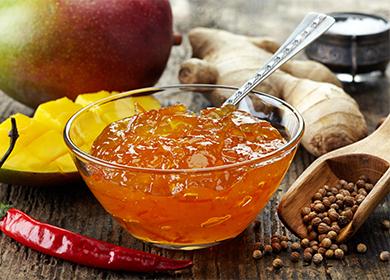About three millennia, people have known the taste and healing properties of ginger. Deer-like root was first cultivated in India. Later it gained distribution in Greece, Egypt, Rome, where its warming properties were especially appreciated. Throughout the world, ginger spread thanks to sailors who not only saved them from seasickness, but also actively sold it on land.
Features of the horned root
From time immemorial, ginger has been used not only in cooking, but also in medicine. It has been successfully used to treat a number of ailments. But not for everyone, ginger is useful and safe. Before you master the recipe for ginger jam, familiarize yourself with the beneficial properties and contraindications of the product.
Benefit
The composition of ginger includes more than 400 substances necessary to maintain good health. The benefits of this spice extend to almost all body systems.
- For the stomach and intestines. Ginger promotes the synthesis of gastric juice, which stimulates appetite, suppress flatulence, and cope with diarrhea. Eliminates nausea and vomiting. It can be used to combat motion sickness. Ginger also normalizes the consistency of bile, which contributes to its normal outflow through the channels.
- From parasites. Ginger essential oil contains zingiberins, aldehydes, sequiterpenes and other substances that are usually included in anthelmintic preparations.
- From a cold. Ginger contains cineol, which has pronounced antiseptic properties, and also helps to eliminate sputum.
- From pain. Blocks discomfort with migraines, arthritis, osteochondrosis. Also relieves pain during menstruation.
- For the heart and blood vessels. Helps dilute blood and improve cerebral circulation. Ginger also has beneficial effects on the functioning of the heart muscle.
- For weight loss. Due to the acceleration of metabolic processes, the fight against excess weight is greatly facilitated.
- For male and female health. Regular use of ginger contributes to the treatment of infertility, enhances sex drive, reduces the risk of pelvic diseases.
- For immunity. Ascorbic acid helps strengthen the body's defenses. Ginger also has bactericidal and antimicrobial properties.
- From intoxication. The substances that make up ginger have the ability to detect, bind and remove harmful substances in the blood from the body.
- For beauty. Eliminates dermatological problems, improves the condition and appearance of hair.

Contraindications
Ginger is a rather specific spice. This applies not only to taste, but also to the effect on the body. There are a number of contraindications to the use of ginger or jam based on it. It:
- damage to the mucous membranes of the oral cavity, stomach or intestines;
- liver diseases associated with inflammatory processes;
- urolithiasis disease;
- poor blood coagulation and a tendency to bleeding;
- previous strokes or heart attacks;
- second and third trimesters of pregnancy;
- lactation period;
- children's age up to two years;
- taking sugar-lowering drugs;
- hemorrhoids;
- allergy or individual intolerance.
Ginger Jam: 6 Popular Recipes
If you want to surprise guests or family members, forget for a while about the classic jam from berries and fruits. How about making a tasty and wholesome ginger root from Finland? Despite the fact that in raw form this product is not at all sweet and slightly resembles dessert, using a step-by-step recipe it will not be difficult to turn it into jam.
No. 1: Classic
Features If you often suffer from a cold, try making ginger jam with lemon according to the classic recipe. By regularly adding this delicacy of lemons to tea, you can strengthen your immune system and make your body more resistant to infections.
What is in the composition:
- root - 250 g;
- sugar - four glasses;
- lemon juice - half a glass;
- a pinch of salt.
Action list
- Ginger should be well washed, peeled, freed from the core and cut into thin plates or strips.
- Pour the raw material with cold water and leave for two days so that bitterness leaves the root. During this time, you need to change the water five to six times.
- Transfer the ginger to the pan, fill it with water so that it is completely covered.
- Boil over low heat for an hour.
- Let the broth cool, then add sugar, salt and lemon juice to it. Place the pan over medium heat again.
- When the jam boils, turn on the gas more strongly and cook for another five minutes, stirring constantly.

No. 2: Squash and Apple
Features Zucchini, neutral in taste and texture, goes well with ginger. The vegetable absorbs the taste of the root. Thus, the jam will turn out less spicy.
What is in the composition:
- root - 250 g;
- sugar - 1 kg;
- a glass of lemon juice;
- large apple;
- zucchini - 1 kg;
- glass of water.
Action list
- Zucchini free from seeds and peel, then cut into cubes. If you want the dessert to have the consistency of jam, pass it through a meat grinder.
- The root freed from the peel and the core, as well as the peeled apple, need to be grated or ground in a blender.
- Place water, a third of lemon juice and sugar in a saucepan and place on the burner.
- Heat the syrup until the sugar has completely dissolved.
- In a separate container, heat the remaining lemon juice with root, zucchini and apple. When the mass boils, combine it with syrup.
- Boil the mixture for 40 minutes, stirring constantly.
No. 3: Citrus
Features If you dilute fresh citrus notes with spicy spiciness of ginger, you get excellent jam. In addition, sweet orange is not less rich in vitamins than lemon.
What is in the composition:
- six oranges;
- root - 120 g;
- three glasses of water;
- a teaspoon of vanilla sugar.
Action list
- Wash the oranges, remove the zest from them.
- Cut the fruits themselves into slices.
- Pour water into the pan and place on the stove.
- When the liquid boils, add sugar and cook until the granules are completely dissolved. The syrup should slightly thicken.
- Place the orange slices in boiling syrup and boil for five minutes.
- Leave the mass to infuse for a day.
- Peel the root, cut into strips and fill with water. It also needs to be left for a day.
- Put the pan with syrup on the ring again, adding the dried root, zest and vanilla sugar to it.
- Five to ten minutes after boiling, the jam will be ready.

No. 4: Pear
Features Pear jam is always tasty and aromatic. But if it seems too cloying to you, you can give it a piquant pungency with ginger.
What is in the composition:
- pears - 1 kg;
- glass of water;
- sugar - 800 g;
- root - 50 g.
Action list
- Peeled and freed core ingredients put in a pan, fill with water and add sugar.
- Cook until sugar dissolves.
- Peel the pears from the peel and core, then cut into small slices.
- Place them in a completely cooled syrup and let it brew for 12 hours.
- Put the pan back on the burner and bring to a boil.
- Boil another quarter hour and allow to cool completely.
- Repeat the indicated cycle three more times.
No. 5: Dietary
Features If you want to preserve all the benefits of the plant, it is better not to heat it. Moreover, dessert can be cooked without cooking. Moreover, this is an ideal recipe for weight loss, because it does not contain sugar.
What is in the composition:
- root - 250 g;
- a glass of liquid honey.
Action list
- Wash the root and peel it. The core can not be removed.
- Pass the raw material through a meat grinder.
- Mix the resulting mass with a bee product.
No. 6: For the sweet tooth
Features If you consider yourself a sweet tooth, make ginger and lemon jam with dried apricots. Such a treat can serve not only as an excellent addition to tea and toasts, but also as a filling for your favorite pastries.
What is in the composition:
- root - 250 g;
- sugar - 300 g;
- a glass of dried apricots;
- half a glass of water;
- lemon.
Action list
- Wash the root, peel and peel the root, then cut into thin plates.
- Transfer the raw materials into a large bowl, fill with water and leave for two days.
- Every five to six hours, change the water and mix the raw materials.
- Dip dried apricots in boiling water for a couple of hours, then chop it. You can simply divide it in half, or you can cut it into small cubes.
- Put the root, dried apricots, sugar in a saucepan and pour half a glass of water. Boil the mixture over low heat until the sugar has dissolved.
- Turn off the stove and let the mixture cool for a couple of hours.
- Bring the jam back to a boil and boil for ten minutes. After this, the mixture again should completely cool.
- Squeeze the juice from the lemon, add it to the jam and mix well.
- Boil the mixture for the last time, boil for a quarter of an hour and pour into jars.

8 additional tips
No matter how accurately you follow the recipe, you can’t cook a good jam without knowing some secrets. The hostess reviews contain a number of recommendations for the preparation of a spicy ginger dessert.
- Raw material selection. Try to buy light-colored roots. The peel should be clean, without spots. The best taste is characterized by young roots of a small size.
- Preliminary preparation. Before you start making jam, ginger needs to be washed well. It is better to do this with a sponge, as the roots could well be chemically treated.
- Cutting. For the preparation of delicacies, you will need that part of ginger, which is located between the core and peel. The exception is young roots, which can be sent to jam completely.
- The core is also useful. The fibrous part can be used when cooking syrup to give it a more rich taste. But putting it in jars is not worth it, because even after prolonged cooking, the core remains rubber.
- Instruments. To preserve the spicy taste of ginger, during cooking, stir it with a wooden spatula, not a plastic or silicone one.
- Proper utensils. To preserve the taste of ginger, jam is best cooked in a copper or enamel container. In extreme cases, you can use stainless steel utensils.
- Precautionary measures. Ginger jam often burns. To avoid this problem, steam the treat. Of course, it will take a lot of time, but in the finished product there will be no aftertaste and smell of burning.
- Storage. Ginger jam is rolled into sterilized jars washed with soda. You need to store it in a cellar, dark pantry or refrigerator.
In domestic consciousness, love for ginger arose not so long ago. At the same time, in Australia, India, China and other warm countries, this plant has been cultivated and used for millennia. As for Europe, here overseas spice appeared during the plague epidemic, as a medicine. People were ready to give fabulous sums for a healing root, without even knowing how to use it. Fortunately, mankind has got rid of a terrible epidemic, but the value of this product has not been forgotten. To maintain good health and good health, learn the recipe for ginger jam.
Other homemade recipes
Pickled honey mushrooms
Pickled porcini mushrooms
Pickled mushrooms for the winter
Mushroom caviar

